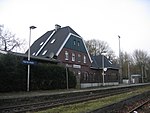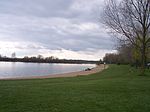Hamminkeln

Hamminkeln (German pronunciation: [haˈmɪŋkl̩n] ) is a town in the district of Wesel, in North Rhine-Westphalia, Germany. It is situated on the river Issel, approximately 10 kilometers north of Wesel and 15 km south of Bocholt. It is twinned with Sedgefield, United Kingdom and the largest town in the district of Wesel. The town is separated into the villages Ringenberg, Dingden, Mehrhoog, Brünen, Marienthal, Loikum and Wertherbruch. The city has 3 major employers: Thunderbike - A motorcycle manufacturer and well known customizer of Harley-Davidson Max Bögl - A manufacturer of concrete parts for tunnels and bridges, who has worked on projects like Eurotunnel Bonita - A big fashion brand in GermanyHamminkeln has its own exit from the Bundesautobahn 3 which is used for many nearby larger cities.
Excerpt from the Wikipedia article Hamminkeln (License: CC BY-SA 3.0, Authors, Images).Hamminkeln
Martin-Luther-Straße,
Geographical coordinates (GPS) Address Nearby Places Show on map
Geographical coordinates (GPS)
| Latitude | Longitude |
|---|---|
| N 51.731944444444 ° | E 6.5908333333333 ° |
Address
Martin-Luther-Straße 17
46499 , Ringenberg
North Rhine-Westphalia, Germany
Open on Google Maps











